With an evening arrival to the Pueblo Magico of Guanajuato, our first orders of business (after finding lodging, showers, and just, staring at the wall for a bit) was to celebrate Neon’s birthday! I’d found a list of great little restaurants and let the foodie have her pick. We ended up on a lovely rooftop, overlooking the valley city and the huge statue to Pipila.
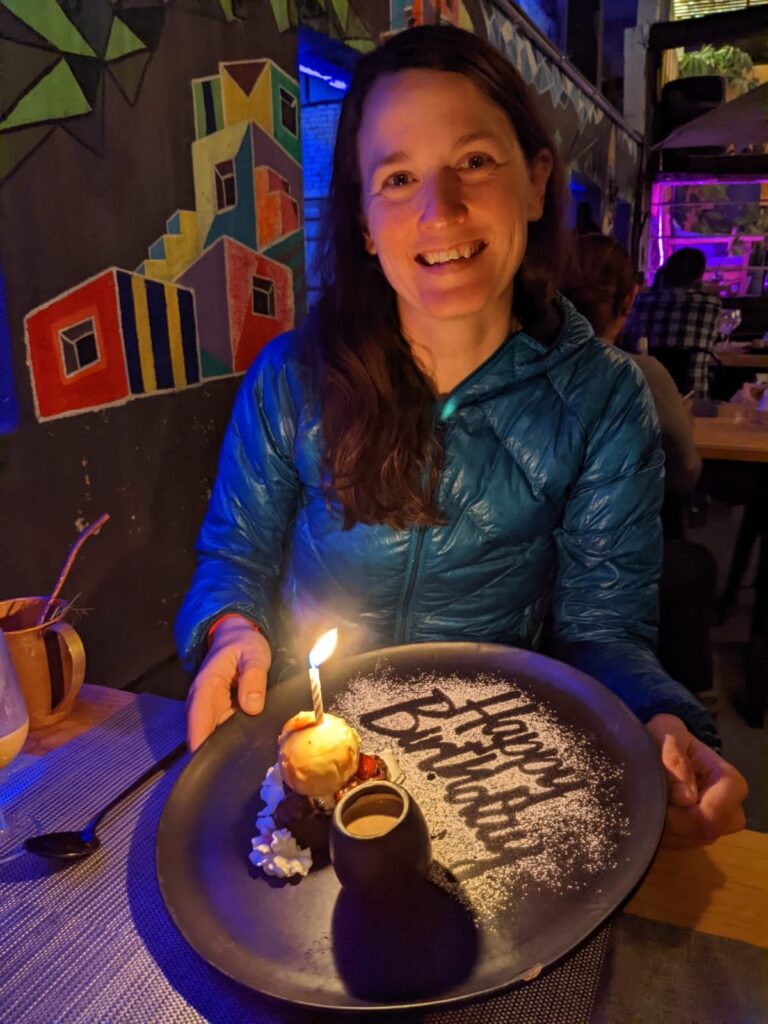
The next order of business is always laundry, since this usually takes at least 24 hours. You also, simply, cannot go wrong with the rich hues and colors down here.
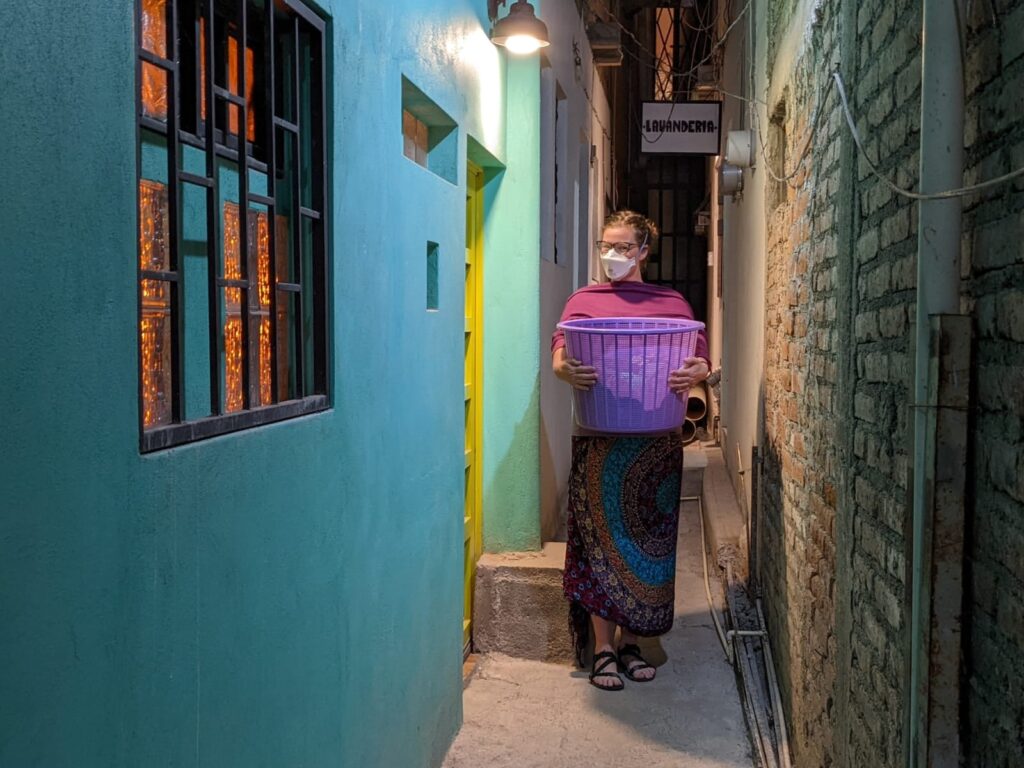
We often see men in cowboy hats with guitars slung over their backs, in the same fashion as we saw men with guns in other countries. Like they might need to shoot you a song at any moment (and sometimes they do).
On the dirty, industrial outskirts of the city, out of sight of most of us visitors, where all the tire shops and mountains of trash are, we also almost always see old men riding rusty, 3 wheeled bike carts loaded with scrap metal and recyclables.
On a large hill, I watched one of the guitar men get off his horse and tie it to a street post, to help an old man who was trying to push his cart up the hill in traffic. Together, their heads lowered, they strained slowly upwards.
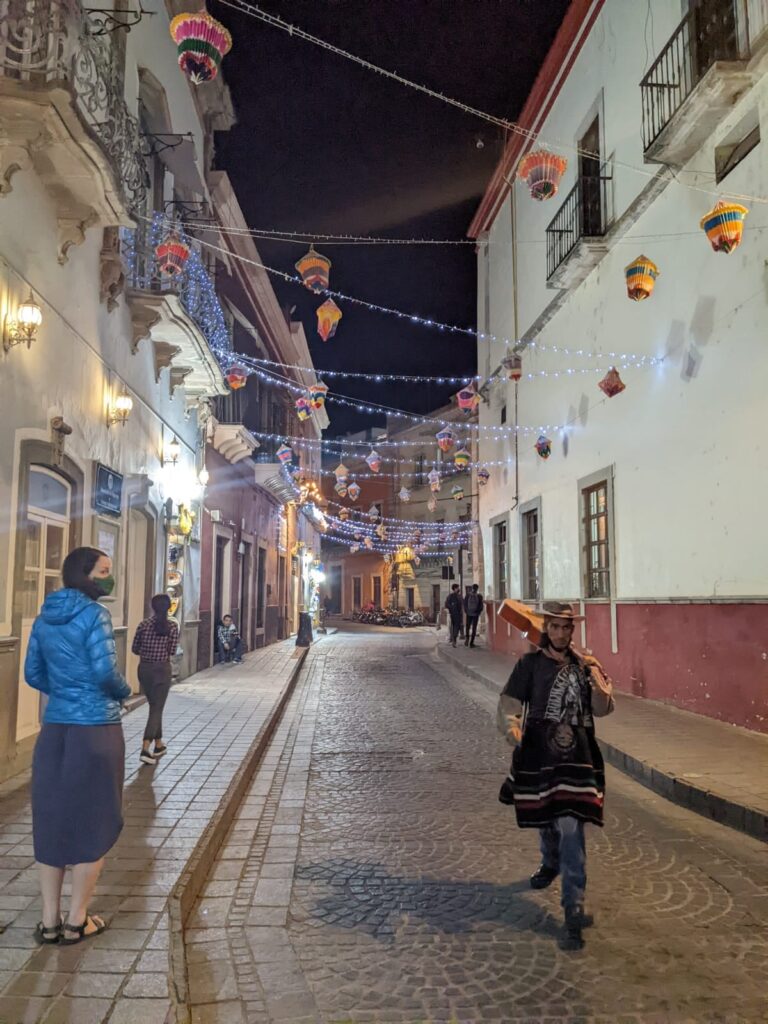
Another site I love is seeing several people feeding birds. Like this fellow, out in the morning in Guanajuato, when the streets are quiet, breaking up and throwing bits of bread to a cooing crew. He caught me watching and seemed about to be embarrassed until I grinned widely and we nodded to one another. A pact, acknowledgment, and kinship. In the end, the birds will feed on all of us anyway, why not choose to share in life as well.
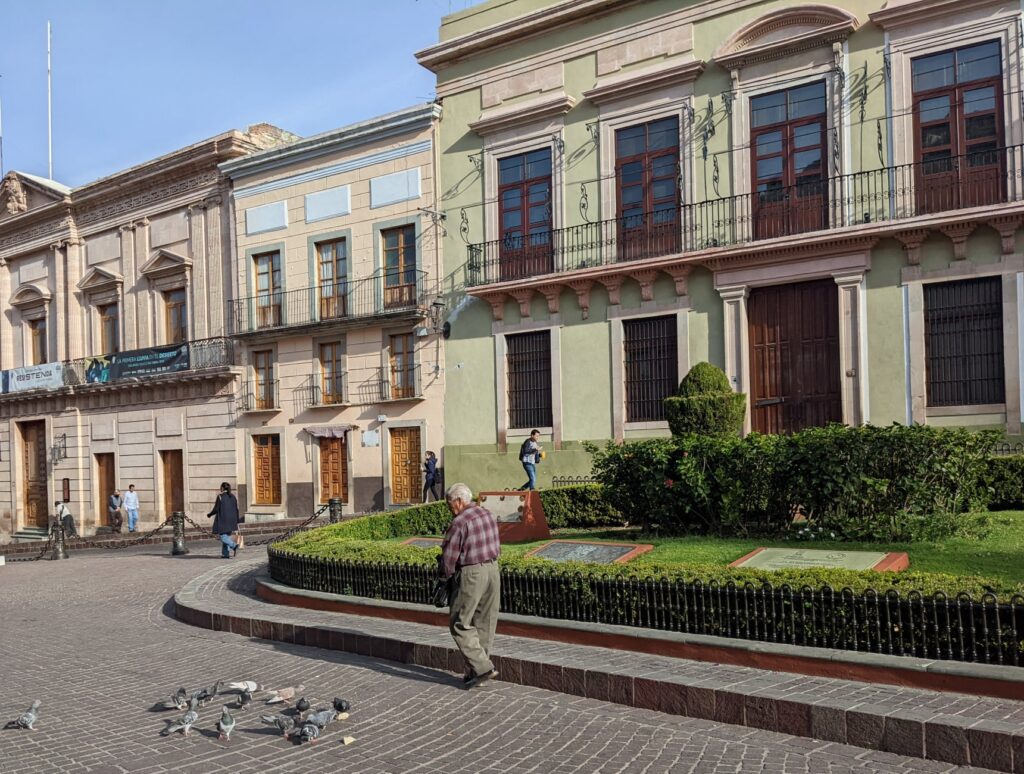
Guanajuato is known for its subterranean network of road tunnels. Originally built to reduce how often the river flooded the city and later used for channeling water in this mining town, it is now a road system. Of an afternoon or evening you can join any of a number of tours to learn more about this UNESCO designated city by buying a ticket from any of the many pantalooned locals working with the project. The groups in the evening are boisterous, encourage laughter and mirth, available in many languages and often come accompanied by their own mariachi bands! These accessible tours will introduce you to any of the many nooks in the winding city.
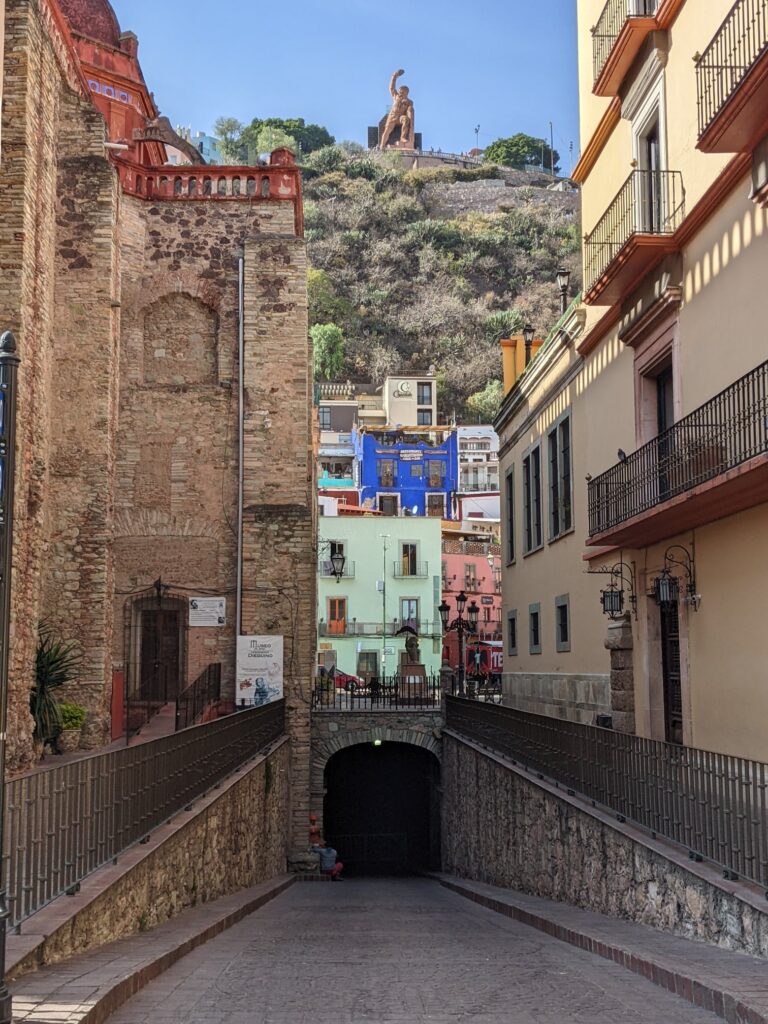
We prefer a quieter, more independent tract but still wandered underground where, while Neon was taking a picture of me, a local teacher walking past came to pose and grin with me. It was delightful to be so welcomed by all fronts of the local population, whether employed in such or just on their way to work. It made me giggle. In general down here, I have found people less judgmental of selfie taking and photography efforts. Quite the opposite, people tend to try to be respectful, to stay out of the background, or wait their turns to take a photo at a good spot rather than crowding in and being inconvenienced by one another. It’s an interesting difference.
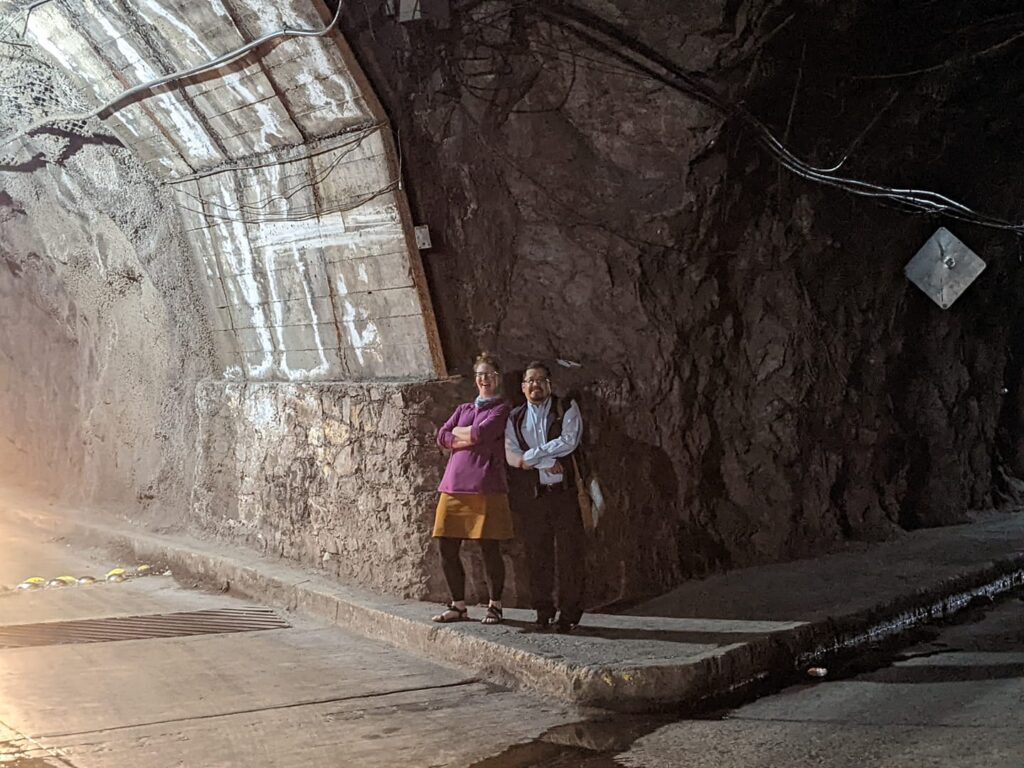
We were really excited by the number of museum opportunities in the city. At first we had thought to go to the Museo de las Momias but for reasons noted at the end of this post, decided against it. Instead, followed my curiosity and heart to the Don Quixote Iconography Museum. Anyone who has dared to dream the impossible dream can connect her story with the Sad Knight and any aspiring author can admire Cervantes’ writing style. I found myself further moved by the story of Ferrer; a refugee from the Spanish war who drew sustenance from this text through his darkest spell and went on to dedicate his life to promoting literacy. From my own end, I began this journey feeling like Odysseus, though these days, what moves and guides me is more in the realm of dreams and madness.
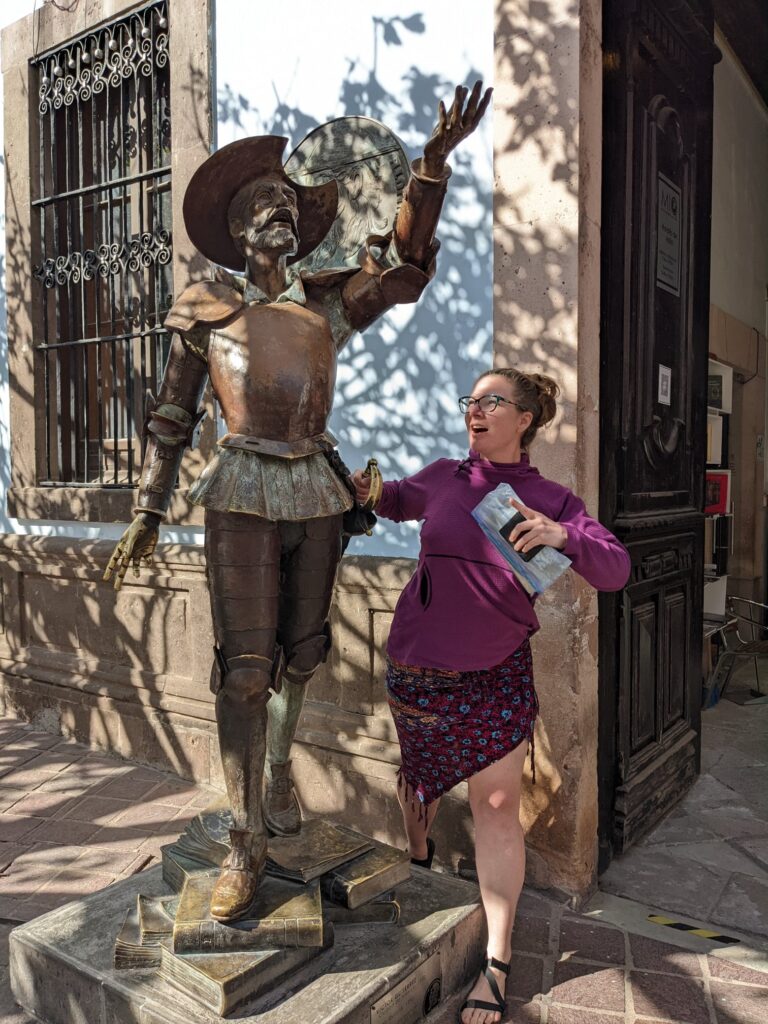
“the most precious gift for a poor man is a library, and the most powerful magic is books” -Eulalio Ferrer
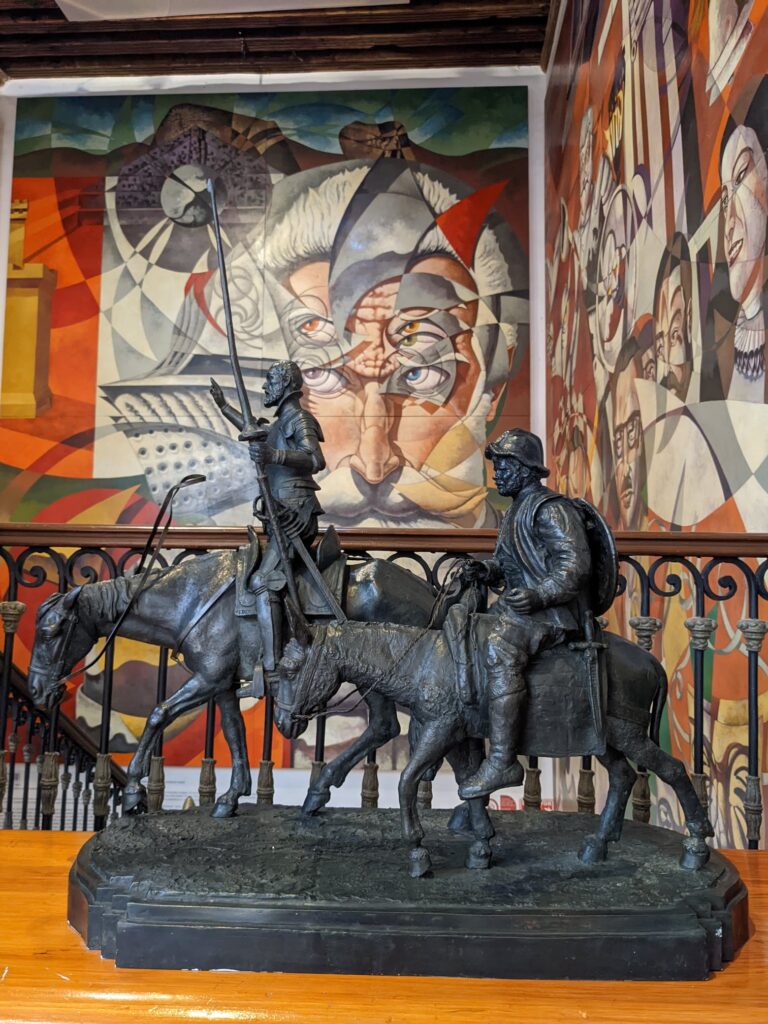
A magical city indeed, alive with princesses, wandering the streets and cathedrals in gowns on a Saturday afternoon. A baby dressed for baptism, carried by her beaming parents like a sacred relic. I couldn’t help but coo admiringly at the precious, chubby baby face poking out amidst the lace. An entire street corner of girls in white with ribbons for their first communion. Gowned princesses for their quinceañeras being followed by packs of friends or processions of brothers in suits. And of course, novias (brides) beneath veils outside the cathedrals. All I could give was my honest admiration and praise.
As a tourist at these moments, the best you can give is your respect from a distance. Whether a wedding procession or funeral, we stop and stand aside, remove our helmets and give just a few moments of our day to honor life. These are the things we don’t have pictures of, because that seems to me, inappropriate. However, amidst the bustle and distraction, from the second story café window where we sat watching, I couldn’t help but steal a snap to try to explain it to you.
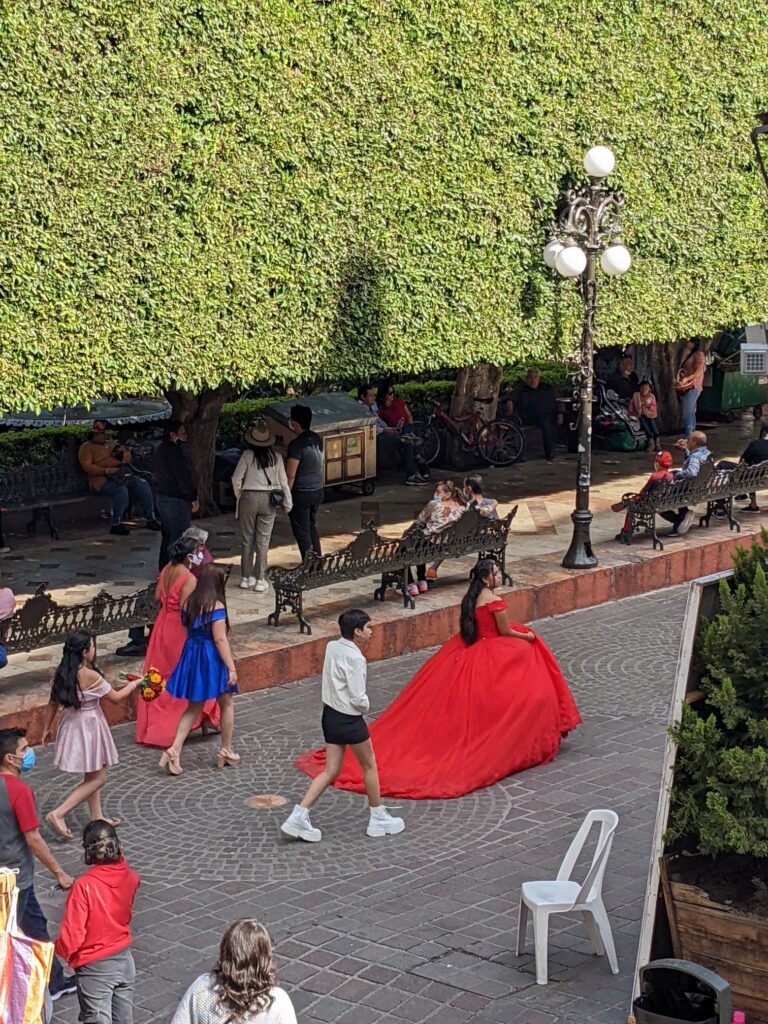
We enjoyed watching the hoop skirts, hoopla, and noticing details like pink platform tennis shoes underneath as the various princesses climbed the stairs to the chapel. It got us to discussing the tradition of dresses, of families spending so much money and time and effort to mark the different points of passage (a way of community giving rooted back in Mayan traditions). Neon asked if there was a right of passage as defined for the young men. Nothing so public, I could think of, besides maybe a first cabalgata, sporting, or military event?
Club music thumps until 3 am, and the streets are quiet and empty in the morning, except of the birds, elders, street cleaners, and educators. Making it my favorite time to wander alone. An aficionado of the stories kept in alleys and graffitti, I snapped a picture of this one.
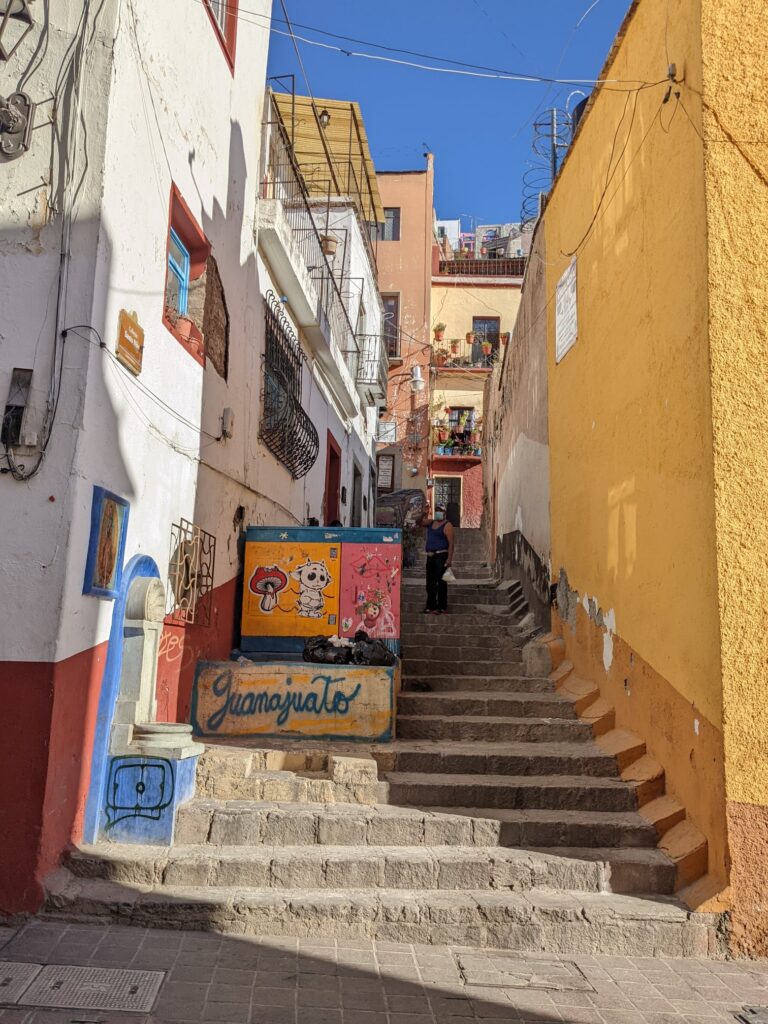
The local men up the stairs having a chat, called out teasing me in Spanish,
“ni me he puesto mi maquillaje!”
I happily shot back, “pero que eres tan guapo, ya mejoraste mi foto!”
He curtsied, all of us laughing and I ambled on.
I love how easily people laugh, here.
Also, he spoke a valuable truth. How often we as interlopers, in search of an ‘authentic shot’, take them of locals just going about their days.
Imagine yourself going to the laundry room in the back of your house. Your hair is a mess, the kids are being unruly, you’re in your frumpy sweats, it’s just been. a day. As you are loading the washer, a minor celebrity walks past and stares at you. You can’t say what movie you have seen them in, you just know they have that look, dress strangely, plus, seem to be out in the streets doing some weird performance art piece. But they stop, pull out a camera, and take a picture of you in this vulnerable, messy moment and then walk off. To do what with that picture? You have no idea but can only guess, to show it to their fellow rich famous people and laugh at you. Or maybe make money off of selling your lived experience.
I’ve found Mexican people to be beautiful, proud, and love being admired and photographed at the right moments. Reading for the right moment (like when someone is clearly in full princess mode and you express admiration as well as take photographs, the attention will help nourish her in that space).
Where it does not detract from the moment for them, asking to take a photograph is important. When I’ve had pictures taken against my wishes the worst feeling is when people are trying to be sneaky about it. It just feels, gross. Done right, it furthers dignity rather than detracting from it. I will ask farmers working their fields if I can take a photograph and they sweep their hands expansively, or insist I move down a couple rows to where the agave are larger.
Creating space for locals to invite you, to choose to share what is theirs rather than you just *taking* changes the tenor of the experience. I always wish them a “buena cosecha,” as I ride away. My picture is but a glimpse. This field is their livelihood. I’m not saying don’t take pictures of life happening, I am saying factor in their mental framework half as much as you spend framing the shot and I think it will be a huge step toward greater respect.
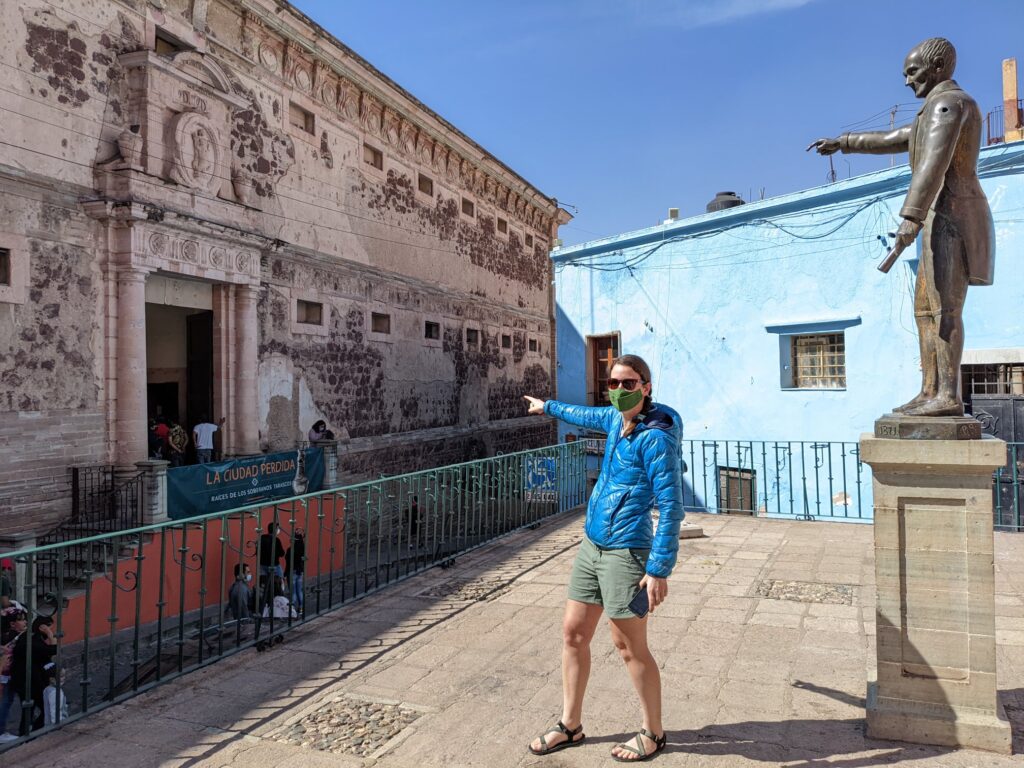
We spent most of the day in the Alhondiga de Granaditas Historical Museum. Offering a comprehensive overview of the history of this region named for “Mountainous place where frogs abound.”
Neon is pointing at the door by which the rebel army (20,000 locals with stones) took the grainhouse stronghold of the last of the loyalists (300 with guns and cannons).
Here the story of Pipila was born.
A poor boy from the mines strapped a rock to his back to approach the wall from which the Spanish were shooting and pouring hot tar down. He approached the door and set it aflame. In some of the murals I’ve seen, his torch is helped by Quetzalcoatl, the god of sun and wind to set the gate aflame.
A 16 yo boy from the fight reports that Pipila is a legend but he stands for the determination and strength of the impoverished campesinos and an elaborate huge statue of a muscular man beneath a millstone adorns one of the steep hillsides. Much like the story of the Niños Héroes, myth and fact dance together differently here in the land of magical realism.
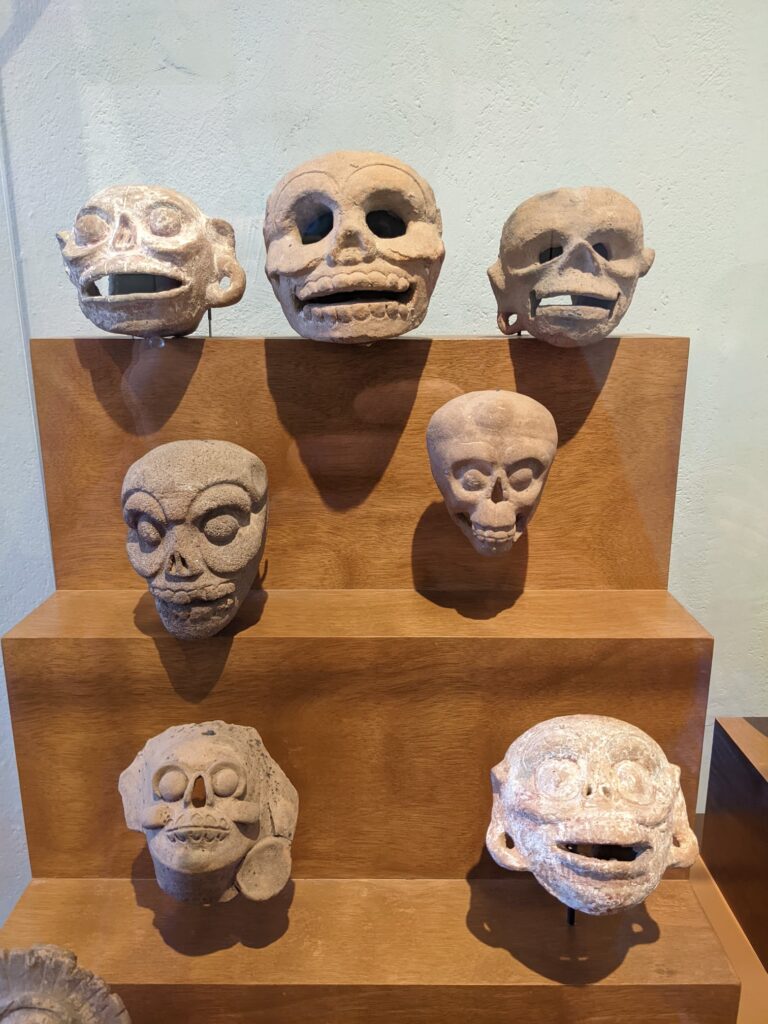
Epochs have been spent living out, and books have been written about the calaveras, the tradition which dates back to well before our beloved Posada, before the concept of ‘Mexico’ even existed. These Aztec figures were fascinating. The various rooms of the grainhouse hold different ages of history, from the most ancient through the Revolution up to the modern.
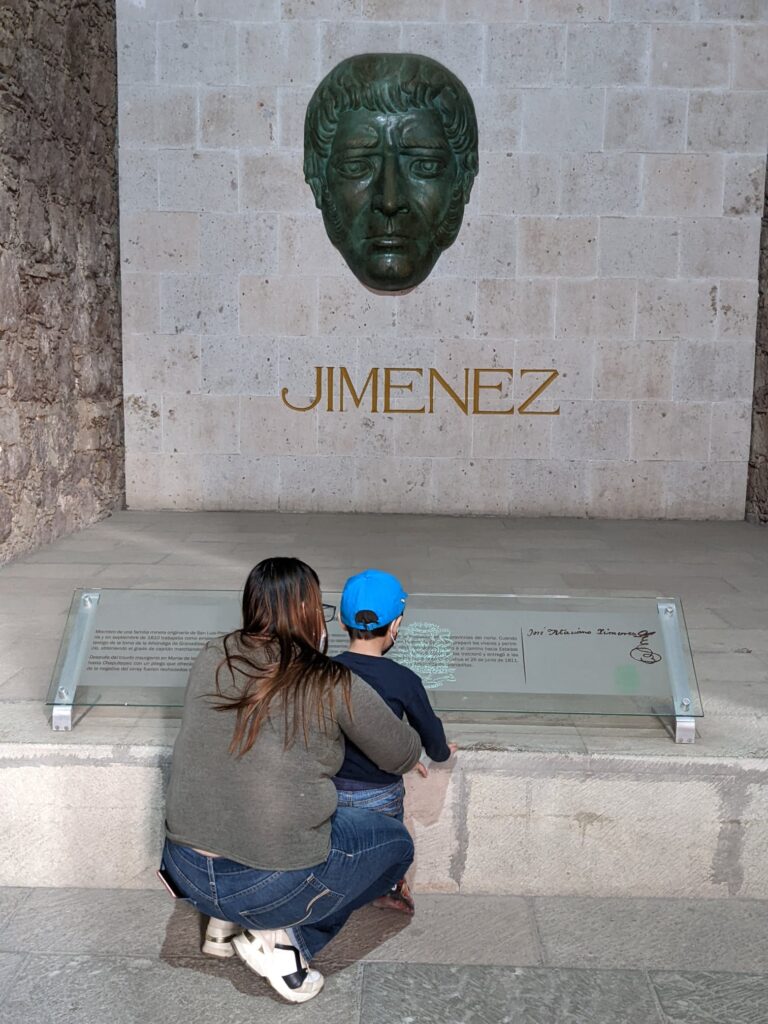
I’m always interested to overhear how parents explain the history of their country to their children. I believe it whispers of how the future will go. Thus, I walked through the various rooms to the Central Characters of the Revolution in the company of this pair. Of their conversations about the man for whom our next city stop was named:
“Y como se llama el?” 5 yo asks. (and what’s his name?)
“Ignacio Allende,” mother says.
“Ignacio?” He repeats.
“Allende,” she repeats patiently as he practices wrapping his mouth around the LL sound.
“Y sigue llamado así?” he inquires. (is he still named that?)
They discuss whether the dead get to keep their names.
…
“y porque se les cortaron la cabeza?” (why’d they cut his head off?!)
She sighs, “ay mi amor, pero como te explico tantas cosas?” (oh my love, how can I explain such things to you) She glanced over her shoulder at me, seeming to seek some sort of assurance, or maybe it was embarrassment but I smiled sympathetically and encouragingly.
He asks again at the next bust and she squats down and holds him close, murmuring the story, keeping it between them.
…
He steps back, horrified, “yo no quiero que se me cortan la cabeza!” (but I don’t want them to cut my head off!)
“No mi amor, ya no hacen tal cosas.” (No my love, we don’t do those sorts of things anymore.)
A note regarding the popular Museo de las Momias:
We’d been hearing about the ‘museum’ for over 100 km as we approached. We were curious and excited and had it on our ‘must see’ list because of so many recommendations. The day we planned to go, as I was reading about it and trying to figure out the history of the mummies, I learned the corpses were preserved by the natural characters of the environment and soil around the city. That in fact, the ‘mummies’ were bodies exhumed from the graveyard when family members could not afford to keep paying for the plots. From Atlas Obscura:
the subjects . . . were not so much discovered as evicted. From 1865 to 1958, the town of Guanajuato, Mexico, required that relatives pay a grave tax. When the relatives failed to do so for three years in a row, their deceased loved ones were promptly dug up and evicted.
. . . Perhaps the most shocking to visitors are the pregnant mummy and the shrunken child mummies, including “the world’s smallest mummy,” which is no bigger than a loaf of bread.
That, combined with a lack of signage or effort to provide information or honor the dead, instead capitalizing on macabre voyeurism, caused us to change our plans. We both have friends and family members who have lost children and loved ones. It would break their hearts to have their dearly departed displayed in this manner.
While the Mexican Government stands behind this museum, we would rather not support it and instead spent a delightful morning at fascinating and quiet Don Quixote Museum. Mr. Ferrer’s foundation continues to work with young artists and indigenous populations to promote art and literacy.
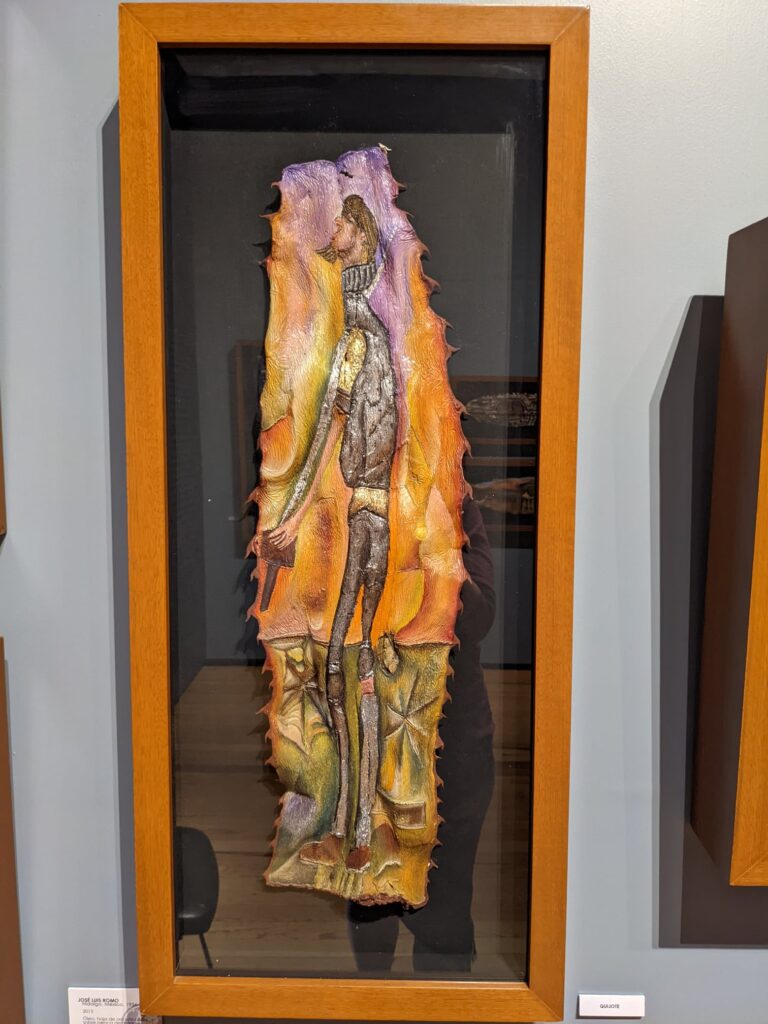






Comments (6)
Wonderful post!!!
I feel like I just ate the richest of Sunday morning brunches with unusual colors, flavors, textures, and scents to fatten my soul. Thank you for all the time you spend practicing your craft and sharing it with us.
Your choice of the Don Quixote Museum makes my heart smile. You both bring Cervantes’ message to life for all your readers.
Love your blog. So glad we met at Udo’s in Copán Ruinas.
It was so fun meeting you all as well. Thank you for subscribing and keep up the good works!
Pingback: Bikepacking: Guanajuato to the Monarch Butterfly Preserves – Her Odyssey